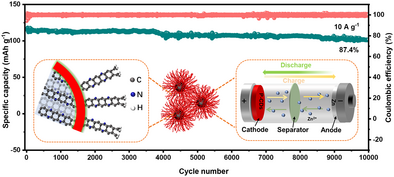High-Capacity and Long-Life Cathode Constructed Solely by Carbon Dots for Aqueous Zinc-Ion Batteries
Graphical Abstract
Abstract
Carbon dots (CDs) have been explored widely in the electrochemistry field, owing to their unique structures and rich properties. However, in the reported devices, such as batteries and supercapacitors, CDs are always used as additives to modify the electrodes or regulate the electrolytes because they have been regarded as inert and low-capacity materials all along. Here, for the first time, o-phenylenediamine derived CDs are selected as the only protagonist to construct cathode materials for aqueous zinc-ion batteries (ZIBs). Such CDs (p-CDs) have a special π-conjugated phenazine-based structure, with carbon cores for electrical conductivity and active sites for embedding Zn2+ and H+. The p-CDs solely constructed cathode material delivers a superior capacity of 290 mAh g−1 at 0.1 A g−1 and a decent capacity of 103 mAh g−1 at an ultra-high current density of 10 A g−1, as well as an ultrahigh ion diffusion coefficient of 10−8 ∼ 10−7 cm2 s−1. The p-CDs assembled ZIBs exhibit a stable long-term cycling, retaining 87.4% of the original capacity after 10 000 cycles. Various characterizations and theoretical calculations prove that the electron-deficient N as the active sites on p-CDs can embed/release Zn2+ and H+ reversibly.
Conflict of Interests
The authors declare no conflict of interest.
Open Research
Data Availability Statement
The data that support the findings of this study are available from the corresponding author upon reasonable request.





